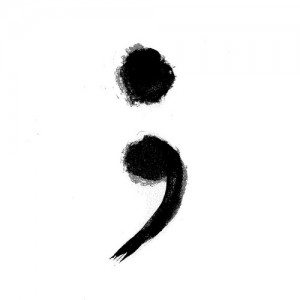After my post about em dashes, a friend of mine suggested I write a post about semicolons. Those little buggers can be tricky. Since I didn’t have a clear idea of what I was going to write about this week, I thought I would go with my friend’s idea instead. I must give a tip of the hat to Mrs. Fala.
I happen to love punctuation. The fact that it can be used in so many ways makes me happy. There are some classic conventions, but if you know what you’re doing . . . you can get away with some amazing things. Writing about punctuation makes me smile. Talking about it also makes me grin; I know this makes me a writing geek, and I’m okay with that.
Back to semicolons! At one point in my school career, I took a Critical Theory class. The class was taught by a grad student with grand aspirations. Instead of inspiring us, she came off as a waspy, self-obsessed, pain-in-the-neck. Not only that, but she thought science was icky. Needless to say, she and I didn’t get along. I definitely pushed the envelop with her, and wrote a few really fun essays; including an essay with the thesis statement, Dinosaurs are Rad! I got to write about the velocirapture, so the class wasn’t a total waste.
She often called on her students to give examples of grammar and punctuation. I couldn’t tell if it was because she didn’t know, or because she liked to think we were idiots and we didn’t know. Keep this in mind; it was a three hundred level class, where one would hope that the students had a general grasp of the English language. One day she called on me. The conversation went thusly:
“Dylan, can you give us a sentence using a semicolon?” She asked.
“The house was made of logs; the dog was outside.” (It was the first thing I could think of on short notice.) I answered.
“Those two things don’t have anything to do with each other, so that isn’t a good example.” She responded, trying to negate the validity of my sentence.
“They do if you’re reading Old Yeller.” I shot back.
So, what does this teach us, other than the fact that I can be a bit of a pain-in-the-neck myself? I think, it teaches us that perception is everything. Sometimes sentences that don’t seem to have anything to do with each other should be connected with a semicolon. They want to snuggle. They want to give life to your prose.
Therein lies the crux of the semicolon; the semicolon snuggles up ideas. You use one when you have a complete sentence, but you just aren’t ready for it to end. In even simpler terms, you use a semicolon to connect two complete, compatible sentences to form one longer sentence to get at what you really want to say. When a comma isn’t enough, and a period is too much—go with a semicolon.
Thanks for reading, please share.

